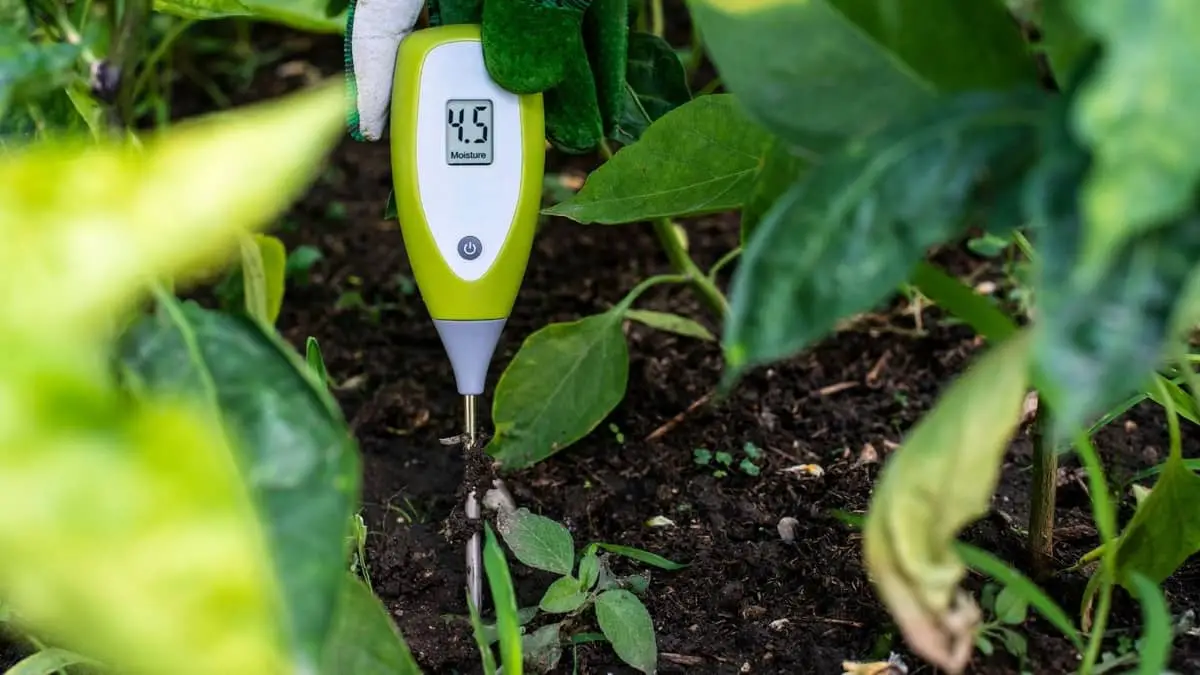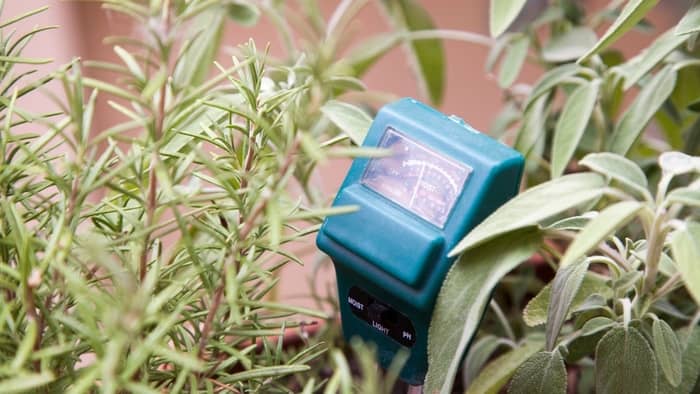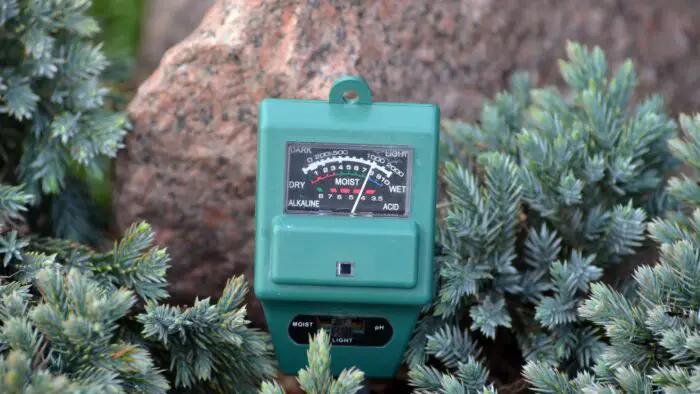Last Updated on March 20, 2023 by Cristina
Have you ever used a ZZ plant moisture meter before? A plant soil moisture meter is a useful tool to allow you to learn how to get the soil moisture levels right for different plants. In this article, we will take a look at a few meter types I have used and review the pros and cons of each one.
Zz Plant Moisture Meter Level – How to Use It?
The ZZ plant moisture meter level is simple and easy to use. Aside from being quite affordable, these electronic gadgets are also quite handy for gardeners and homeowners. To use it, all you have to do is to pop the water meter sensor into the soil, at least to a 1/3rd depth of the plant pot. After just a few minutes, you will have an accurate moisture level reading on the display screen. These useful gadgets tell you when it’s time to water your ZZ plants and is, therefore, perfect for keeping them healthy and happy.
It is also essential to follow the above directions to monitor the soil moisture levels of your ZZ plant. This is because the depth that the meter should be plunged into the growing medium will ensure that it directly reaches the plant root zone. Additionally, 40-50% humidity levels are ideal for indoor ZZ plants as it mimics their native environment. If your ZZ plant is growing in a very deep pot or landscape plant bed in the garden, it is advisable to push the moisture meter sensor into the soil to cover its full length.
When to Water Zz Plant Moisture Meter
So, when to water Zz plant moisture meter? These hardy plants are not very demanding and usually grow well in high and low humidity levels. However, for the best growth and to keep your ZZ plant happy and healthy, moderate humidity is best. To answer the question, ZZ plants should be watered when the moisture meter reading is sitting between the moist and dry indicators.
This will actually mean a moisture level of three or four on your meter is a great indication to quench your plant’s thirst. To ensure the accuracy of your moisture meter, it is advisable to test several spots in the soil a few times. This will give you peace of mind and avoid the hassle of over or underwatering. Keep in mind that moisture level readings taken from the same material in succession should deliver the same reading as it is indicative of a functioning device.
Best Soil Moisture Meter
If you are in search of the best soil moisture meter, then we have a few options for you. While some soil moisture meters perform exceptionally well with unflawed functionality, others may not. For this reason, we thought it our duty to test a few of the most demanded brands to see which ones stood out. Aside from that, we also looked at accuracy, demand, consumer reviews, and affordability to accommodate everyone who is in search of the best soil moisture meter.
Keep in mind that these electrical gadgets are a must-have if you want to maintain healthy indoor or outdoor plants. Not only do they stop the guessing games of whether or not it’s time to water your plants, but they reduce the risk of root rot and other infections and diseases caused by too much or too little water in the soil.
Here’s a list of the soil moisture meters that performed the best:
Our Best Pick: The Efficient ECOWITT Soil Moisture Tester
This device works well for houseplants and garden plants as it delivers accurate readings in minimal time.
Our Best Colorful Pick: The IPPINKA Sustee Aquameter
This device is a simple moisture meter that offers easy use. It comes with sensors that change color to indicate when it’s time to water your plants.
Our Best Budget Pick: The Affordable XLUX Soil Moisture Meter
This gadget is easy to use and light on the pockets, which is a win-win.
Our Best Dual Probe Pick: The Sonkir Soil Meter
Providing a snapshot of light and soil conditions, this soil meter has multiple sensors, which is value for your money. I mean, it’s more than a two-in-one deal.
Our Best Outdoor Pick: The Netro Whisperer
This durable device is versatile and perfect for outdoor use. It is efficient and allows for moisture, sun exposure, and temperature readings, which is a win.
What is a Plant Soil Moisture Meter?
These are generally electronic devices that measure a current flowing through the soil. The flow of current is vaguely calibrated to moisture content. The logic is that moist soil has a greater ability for ions to flow through the soil in the water, hence it will have a lower resistance. Dry soil has little, or no water, in it, and hence acts like a resistor. The meter is then calibrated to turn this into an indication of soil moisture.
Why is Soil Moisture Important?
Different plants have different moisture requirements. As we learn more and more about gardening, we get a sort of feel for what different plants need. At the beginning of this journey, soil moisture meters help us learn the optimal “feel” of soil wetness for different plants.
How Do Different Soil Types Affect Soil Moisture?
When considering soil moisture, we need to consider the type of soil we have, and how this soil works.
Loam
A good well-developed loam soil is quite absorbent and can tolerate brief periods of overwatering. Due to its ability to absorb water, and hold this water, it can also balance water levels better during patches of mild drought. The loam soil can adsorb and hold onto soil nutrients – in other words, if the soil does get slightly overwatered, the soil nutrients do not wash away as fast as in sandy soil.
Loam does not develop a crust when it gets dry, so as soon as it gets watered, the water sinks into the soil. Hence if your loam measures as “dry” and you water it, it will measure as “moist” or “wet” or whatever the settings on your meter measure that are the equivalents of this.
Sand
Sand dries quickly. If you pour water on it, the water just sinks in and runs through the sand. This makes these soils quite difficult to keep moist. It also makes the soils susceptible to overwatering – if you water sand too much, you just wash all the nutrients out of the soil and this will cause your plants to be nutrient deficient. Hence with sandy soil, you can use a meter to measure how much water you need to give plants to make the soil briefly “moist” at the depth the roots are, after which it will dry out. You do not want to water sand more than is needed.
Clay
Clay soil is fiddly soil. If you let it get dry, it will form a crust, and this crust will inhibit water from getting into the soil to moisten it again. Hence you really need to learn how to never let clay soil get dry. However, if you overwater clay soil, it can get waterlogged, which in turn can kill or damage your plants. With a soil moisture meter you can easily learn how to keep your clay soil in the “moist” range, but not let it get “wet” or “dry”.
How to Tell if a Soil Moisture Meter is Any Good?
You get a number of these inexpensive soil moisture meters that say they can measure soil moisture, soil pH, and sometimes a few other bonus factors too. If these meters are very inexpensive, I would treat them with great caution. I actually went to a large garden depot and took five of the same meters from the shelf and inserted them into a cup of soil that I had brought with me. Each soil moisture meter gave a different reading!! This means that the identical meters were not even properly calibrated at the factory.
You can buy a budget meter such as this one. I have actually bought something that looked like this, and the results were somewhat inaccurate. Luckily this pack has two meters – so you can put both of them into the same soil and see if the readings are vaguely the same. This is a simple method to ascertain the level of accuracy of your reading. I would probably only take the soil moisture reading with this – the pH will be horribly inaccurate and the light probably is the same. This is not to say the soil moisture will be accurate at all. Just that it is more likely to be an indication.
If I were to look at a decent entry-level meter I would choose this one because it has a reasonable build quality and the functions that it can perform vaguely correlate to its price. These entry-level meters are relatively accurate on soil moisture and light, but I would take the pH readings with a pinch of salt. There is no logical way these can give an accurate pH reading, which is why soil analysis laboratories still get work actually measuring soil pH – measuring soil pH is a fiddly job.
If you want a more robust meter, I would suggest this unit – it has two options – you can buy a monitor for it, and then insert the moisture meter, or you can just buy the moisture meter and pair it with the app they supply and use your smartphone. These sorts of units tend to provide a slightly more accurate measure of temperature than the handheld unit I showed as the spikes are more sensibly designed. Again, it will take a bit of self-optimization to make sure you are actually getting a real result.
The Best Plant Soil Moisture Meter?
This will eventually be called you. If you learn to feel what your soil moisture feels like and use your meter to get the reading of what it is that you feel, you will eventually become a very accurate soil moisture reader. I walk around my garden and just prod the soil with my finger and have a look at my plants. Over the past few decades, I have got quite good at knowing when I have over or underwatered my plants.
So, while you learn how to be the best plant soil moisture meter, use the various options listed above to get some indication of what it is that you are feeling with your hand. As you build your soil up – by adding nutrients, compost, organic fertilizers, manure, mulch, and earthworms, your soil becomes more and more resilient. You will see that a “very wet” loam, or a “dry” loam probably still has healthier plants than “moist” sand or clay.
Read more about Top List On How To Measure And Use A Rain Gauge
FAQs
What should the moisture meter read?
This will depend on the calibtration of your meter. Most inexpensive (ie less than $150) meters are a bit inaccurate. So you can get a bit of a feeling, but the meters I have seen tend to be acceptable for most common plants when they say "moist".
How much water does a plant need?
This depends on the plant. Rice that grows in a paddy, needs a lot of water. Tomatoes in pots need less water, but they need to remain moist. Cacti thrive if they are watered and then allowed to get to the point where the soil is dry.
Can I leave my moisture meter in my plant?
This will depend on the moisture meter. Some are designed to be in the ground permanently, others have a method of generating electricity by actually making the probe of the sensor into a battery - with time, these senors will actually rust away and stop working. Read the manual and see if the sensor you have is one that can stay in the soil. As a rule of thumb, a hand held sensor is probably not designed to be left in the soil, while a blue tooth one is.
Branko is the world‘s most enthusiastic gardener! He is always on the hunt for the perfect flower, bush or tree to add to his ever–growing garden. He is known for his love of all things green, and his passion for nurturing the plants he grows is unmatched. He loves to get his hands dirty and can often be found humbly tending to his garden at all hours of the day. Branko is the go–to guy when it comes to gardening advice – he is always happy to share his knowledge and wisdom with anyone who will listen. He also loves to play pranks on unsuspecting visitors, so beware if you enter his garden!




